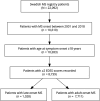Clinical Characteristics and Long-Term Outcomes of Late-Onset Multiple Sclerosis: A Swedish Nationwide Study
- PMID: 38394472
- PMCID: PMC11033980
- DOI: 10.1212/WNL.0000000000208051
Clinical Characteristics and Long-Term Outcomes of Late-Onset Multiple Sclerosis: A Swedish Nationwide Study
Erratum in
-
Clinical Characteristics and Long-Term Outcomes of Late-Onset Multiple Sclerosis: A Swedish Nationwide Study.Neurology. 2024 Oct 8;103(7):e209461. doi: 10.1212/WNL.0000000000209461. Epub 2024 Sep 11. Neurology. 2024. PMID: 39259918 Free PMC article. No abstract available.
Abstract
Background and objectives: Clinical onset of multiple sclerosis (MS) after the age of 50 years is uncommon and associated with a less favorable natural history. The differences in long-term outcomes in patients with late-onset MS (LOMS, onset 50 years or older) and adult-onset MS (AOMS, onset 18 years or older and younger than 50 years) during the disease-modifying therapy (DMT) era have been less studied. This study aimed to compare patient characteristics, DMT exposure, and disability progression in Swedish patients with LOMS and AOMS over 2 decades (2001-2022).
Methods: The nationwide Swedish MS registry was searched for patients with an onset of MS between January 1, 2001, and December 31, 2018, with symptom onset at age 18 years or older and ≥2 recorded Expanded Disability Status Scale (EDSS) scores. Clinical and demographic parameters and exposure to DMT were compared between LOMS and AOMS. Time to disability milestones (EDSS 4 and 6) was assessed using Kaplan-Meier curves and Cox proportional hazards regression models adjusted for sex, disease course, calendar year at onset, and DMT exposure.
Results: Among 8739 patients with MS who met inclusion criteria, 1,028 (11.8%) were LOMS. Primary progressive MS was more frequently diagnosed in LOMS compared with that in AOMS (25.2% vs 4.5%; p < 0.001). Most of the patients had been prescribed DMT, but more rarely in LOMS compared with AOMS (74.7% vs 95.6%; p < 0.001). Less than half of patients with LOMS had been exposed to a high-efficacy DMT (45.8%) compared with 73.5% of AOMS (p < 0.001). The risk of reaching disability milestones was greater for LOMS compared with that for AOMS (EDSS 4; adjusted hazard ratio [aHR] 2.71; 95% CI 2.22-3.30; p < 0.001, and EDSS 6; aHR 2.67; 95% CI 2.12-3.36; p < 0.001).
Discussion: This study distinguishes LOMS as a particularly vulnerable group and clinically supports close vigilance of these patients. Further studies are needed to assess and clarify the benefit of DMT usage in older adults with MS.
Conflict of interest statement
E.F. Mouresan, E. Mentesidou, and A. Berglund declare no conflict of interest: K.A. McKay has received speaker honoraria from Biogen and Sanofi-Aventis and is funded by the Swedish Research Council for Health, Working Life and Welfare, and StratNeuro. J. Hillert received honoraria for serving on advisory boards for Biogen, Bristol-Myers-Squibb, Janssen, Merck KGaA, Novartis, Sandoz, and Sanofi-Genzyme and speaker's fees from Biogen, Janssen, Novartis, Merck, Teva, Sandoz, and Sanofi-Genzyme. He has served as PI for projects sponsored by, or received unrestricted research support from, Biogen, Bristol-Myers-Squibb, Janssen, Merck KGaA, Novartis, Roche, and Sanofi-Genzyme. His MS research is funded by the Swedish Research Council and the Swedish Brain foundation. E. Iacobaeus has received honoraria for serving on advisory boards for Biogen, Sanofi-Genzyme, and Merck and speaker's fees from Biogen and Sanofi-Genzyme. She has received funding from Region Stockholm Clinical Research Appointment and the Lindholm Fredholms foundation. Go to
Figures



Similar articles
-
Is late-onset multiple sclerosis associated with a worse outcome?Neurology. 2006 Sep 26;67(6):954-9. doi: 10.1212/01.wnl.0000237475.01655.9d. Neurology. 2006. PMID: 17000960
-
Clinical Characteristics and Disability Progression of Early- and Late-Onset Multiple Sclerosis Compared to Adult-Onset Multiple Sclerosis.J Clin Med. 2020 May 2;9(5):1326. doi: 10.3390/jcm9051326. J Clin Med. 2020. PMID: 32370288 Free PMC article.
-
Is Time to Reach EDSS 6.0 Faster in Patients with Late-Onset versus Young-Onset Multiple Sclerosis?PLoS One. 2016 Nov 1;11(11):e0165846. doi: 10.1371/journal.pone.0165846. eCollection 2016. PLoS One. 2016. PMID: 27802328 Free PMC article.
-
Late-Onset MS: Disease Course and Safety-Efficacy of DMTS.Front Neurol. 2022 Mar 10;13:829331. doi: 10.3389/fneur.2022.829331. eCollection 2022. Front Neurol. 2022. PMID: 35356454 Free PMC article. Review.
-
Late onset multiple sclerosis: clinical characteristics, prognostic factors and differential diagnosis.Neurol Sci. 2004 Nov;25 Suppl 4:S350-5. doi: 10.1007/s10072-004-0339-8. Neurol Sci. 2004. PMID: 15727232 Review.
Cited by
-
Clinical Characteristics and Long-Term Outcomes of Late-Onset Multiple Sclerosis: A Swedish Nationwide Study.Neurology. 2024 Oct 8;103(7):e209461. doi: 10.1212/WNL.0000000000209461. Epub 2024 Sep 11. Neurology. 2024. PMID: 39259918 Free PMC article. No abstract available.
-
Presence of cortical lesions in older persons with multiple sclerosis and association with cognitive function.Neurol Sci. 2025 Jul;46(7):3165-3173. doi: 10.1007/s10072-025-08141-7. Epub 2025 Mar 26. Neurol Sci. 2025. PMID: 40138064
-
Response to therapy in a cohort of patients with late-onset multiple sclerosis.Mult Scler J Exp Transl Clin. 2025 Jul 29;11(3):20552173251360357. doi: 10.1177/20552173251360357. eCollection 2025 Jul-Sep. Mult Scler J Exp Transl Clin. 2025. PMID: 40756530 Free PMC article.
-
Worse recovery from acute attacks and faster disability accumulation highlights the unmet need for improved treatment in patients with late-onset neuromyelitis optica spectrum disorders (COPTER-LO study).Front Immunol. 2025 Apr 11;16:1575613. doi: 10.3389/fimmu.2025.1575613. eCollection 2025. Front Immunol. 2025. PMID: 40292288 Free PMC article.
-
Multiple Sclerosis After the Age of 50 Years: A Comparative Analysis of Late Onset and Adult Onset.J Clin Neurol. 2025 May;21(3):201-212. doi: 10.3988/jcn.2024.0302. J Clin Neurol. 2025. PMID: 40308015 Free PMC article.
References
MeSH terms
LinkOut - more resources
Full Text Sources
Medical
Miscellaneous
